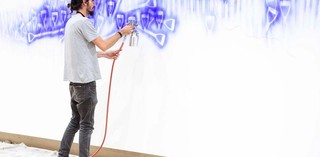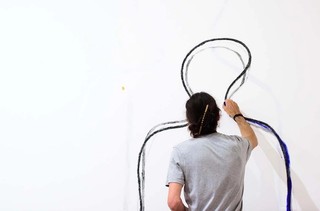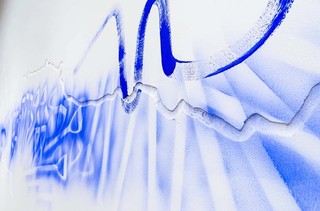View the installation of D Harding’s wall composition

D Harding working on their commission Wall Composition in Reckitt’s Blue / Photograph: Chloe Callistemon © QAGOMA / View full image
View the installation time-lapse of D Harding’s Wall Composition in Reckitt’s Blue 2017, specially commissioned for the Australian art collection. Aboriginal painting represents at least 99 per cent of the timeline of Australian art-making, with a verified history dating back some 28 000 years. Thousands of rock galleries throughout the landscape carry the signs of such art-making and attest to the creativity of the First Australians. This wall composition takes its inspiration from these rock paintings in and around Carnarvon Gorge in central Queensland, home to Harding’s Bidjara, Ghungalu and Garingbal people.
Related: D Harding
Stay Connected: Subscribe to QAGOMA Blog
Watch as D Harding creates Wall Composition in Reckitt’s Blue / Subscribe to QAGOMA YouTube to be the first to go behind-the-scenes
In Wall Composition in Reckitt’s Blue, Harding has introduced an ultramarine blue pigment in place of traditional rock ochres. This blue is made from a powdered laundry detergent called Reckitt’s Blue, which was popular across the colonial frontier in the late nineteenth century. As natural blue pigments were unknown to Aboriginal people, this introduced powder became a popularly traded commodity and was used to paint shields, clubs and boomerangs.

D Harding working on their commission, inspired by rock art / Photograph: Chloe Callistemon © QAGOMA / View full image
In the top right-hand corner of the work, three spectral outlines represent generations of women from Harding’s matrilineal line, who have maintained their knowledge of country. Here, they keep watch over the work in a different kind of gallery. In place of the more common stencils of hands or artefacts, Harding has used a shovel handle as a stencil form. In the same way that everyday objects, such as boomerangs and spears, were used in traditional painting, Harding has used an object at hand – a tool from the floor of their studio. Gouges in the wall simulate natural landforms, ridges and caves, but also refer to the river systems connecting Aboriginal people throughout central and south-east Queensland.

D Harding, Bidjara, Ghungalu and Garingbal peoples, Australia b.1982 / Wall Composition in Reckitt’s Blue 2017 / © D Harding / View full image
D Harding explains the origins, inspiration and deeper meaning of Wall Composition in Reckitt’s Blue currently on show in the reimagined Australian art collection at the Queensland Art Gallery. This wall painting allows us to consider a fuller history of art production in Australia – from Indigenous (pre-European) to colonial to contemporary times – in one richly textured and layered work.
D Harding introduces Wall composition in Reckitt’s Blue / Subscribe to QAGOMA YouTube to be the first to go behind-the-scenes
Subscribe to YouTube to go behind-the-scenes / Watch or Read about the Indigenous Australian Collection
The Australian Collection captures major historical moments from first contact to colonisation, and exploration to immigration. Bringing the Indigenous and contemporary Australian collections together with the Gallery’s historical holdings, the display emphasises stories about Queensland and Brisbane from the region’s own perspective.
Feature image detail: D Harding Wall Composition in Reckitt’s Blue 2017
#DHarding #QAGOMA

